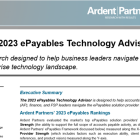Ardent’s FinTech Influencer Series highlights innovative voices in the world of Accounts Payable (“AP”) automation. This series is the go-to spot for progressive thoughts on how technology, transformational thinking, and revolutionary ideas are changing how AP work gets done. Continuing our FinTech Influencer Series, today we are speaking with Todd M. Albers, Senior Payments Consultant, Federal Reserve Bank of Minneapolis.
Ardent Partners: Welcome Todd and thank you for spending some time with me today. Let’s get started, can you provide an overview of the current state of electronic invoicing in the United States? Is it true that a unified e-Invoicing Exchange Framework finally exists? And why is it so important for the US to have a framework in place?
Todd M. Albers: Members of the E-Invoice Exchange Market Pilot have built an electronic invoicing framework that is anticipated to launch this spring. While the framework encourages adoption, the rollout of electronic invoicing in the US has lagged other markets for a variety of reasons – no unified approach to simplify adoption, too many standards, no government mandate from a tax collection standpoint, and many service providers driving different approaches. The concept of an exchange framework – a set of standards, policies, and guidelines bridging various technologies – envisions a unified approach where a business is able to connect once through a service provider and send invoices to any other business. This exchange framework is agnostic to the type of data that can be exchanged, opening the door for a broad spectrum of payment and supply chain related electronic documents. For example, buyers and suppliers who are connected to the exchange framework would be able to send and receive not only e-invoices, but other electronic documents such as remittance information, purchase orders, and advance shipping notices. Businesses could leverage this “digital B2B highway” for electronic data exchange. These are just a few of the reasons why it will be beneficial for the US to have this kind of exchange framework in place.
Ardent: What are other benefits of a unified e-Invoicing framework for businesses and organizations?
TMA: The exchange framework supports businesses in their efforts around payment efficiency and straight-through processing. Invoices received in an electronic format can be automatically processed, which benefits businesses by reducing overall operational costs, combatting fraudulent invoices from entering into approval and payment flows, and accelerating the visibility of payables – all of which help manage cash flows. Also, exchange frameworks can help alleviate the burden of using portals for entering invoice information. Since the start of the pandemic, there has been a proliferation of the use of portals, – and these portals pose a burden on trading parties to manage many different entry points for sending and receiving invoices. For example, we are aware of a company – a participant in the Business Payments Coalition’s E-invoice Exchange Market Pilot – that deals with over 150 portals, and managing these portals has increased that organization’s costs. The exchange framework supports automation for both accounts payable and receivable side, resulting in benefits to both buyers and suppliers.
Ardent: Does the new framework help businesses and organizations ensure compliance with any regulations or standards? What about security and data privacy?
TMA: The pilot program’s exchange framework standards envision businesses exchanging business information securely and privately. Security features include the absence of a central database that could be vulnerable to data breaches or otherwise compromised. Finally, there are processes and procedures in place for accreditation of service providers who enable access to the exchange framework, preventing bad actors from gaining access.
Additionally, the Business Payments Coalition (BPC) has been working with other global exchange framework initiatives — such as Peppol, EESPA, and ConnectOnce — in developing a global interoperability framework where each market can leverage the common set of technical artefacts that enables service providers to exchange invoices in various markets where they operate. For example, a US business will be able to exchange a VAT-compliant invoice with a European customer. Coordination among exchange participants is accomplished via service providers in each market.
Ardent: What are some of the challenges or obstacles to implementing a unified e-invoicing framework in the United States?
TMA: With any new approach or technology, there is always an adoption curve. Fortunately, many of the major e-invoice providers and AP providers who have experience implementing and adopting exchange frameworks are already operating in the US. Leveraging their experiences, the BPC will continue to focus on e-invoice adoption in the near term, advocating for businesses to adopt e-invoicing and begin to access the benefits.
Ardent: How do you see the future of electronic invoicing evolving in the United States?
TMA: I believe the pilot program launching in April will accelerate the adoption of e-invoicing in the US. In the near future, businesses of all sizes will have ways to overcome the technological and cost barriers that have been preventing wide-spread adoption of electronic invoices. I also see the exchange framework extending to other payments and supply chain documents. For example, the Business Payments Coalition and the Federal Reserve are partnering to launch a pilot later this year through the exchange framework for businesses to send and receive electronic remittance information. Receiving electronic remittance information through inconsistent formats presents a significant challenge for businesses managing their receivables and cash application processes. Exchanging e-remittance information through the exchange framework will create the opportunity for a business to truly digitize end-to-end interactions with trading partners – from invoices to payments, and cash application – enabling straight-through processing.
Ardent: Thank you for your insights on the market and I look forward to your presentation — ‘The Exchange Framework is Here! Moving the US Forward with Broad E-Invoice Adoption’ — at the upcoming E-Invoicing Exchange Summit on April 24 – 26 in Miami.



